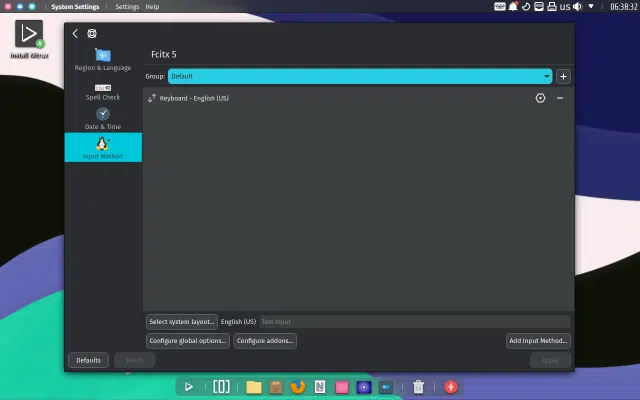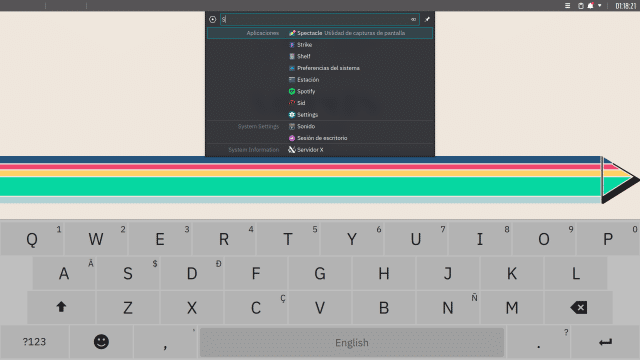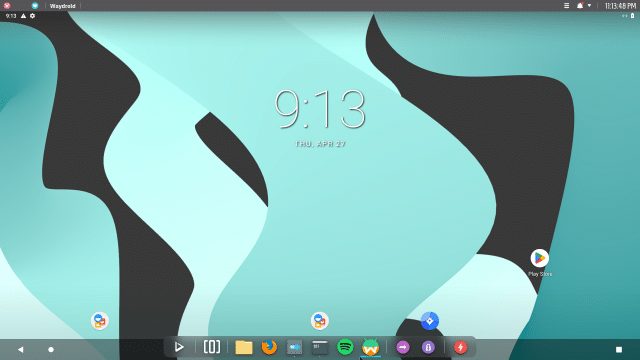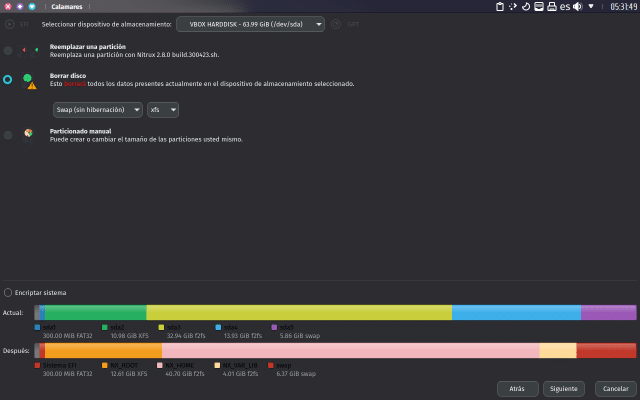Forget Windows 12, Nitrux is your next OS

Microsoft is slowly beginning to kill off Windows 10, stopping major feature updates for the operating system and hoping to persuade more users to move to Windows 11. While that’s the obvious upgrade path, some users will want to hang on for Windows 12, which is reported to be under development at the moment.
But if you’re happy to consider another option, then Nitrux might be the operating system for you.
SEE ALSO: Windows 12 is everything Windows 11 should be
Nitrux is a Linux operating system that’s powered by Debian, KDE Plasma and Frameworks, and AppImages -- and it looks not unlike Windows 11, thanks to its centered taskbar/dock. It's designed to work on desktop and laptop systems, as well as tablets.
You can find out about what it has to offer here.
The team has just rolled out Nitrux 2.8.0 "tf" (the "tf" stands for "tablet Friendly") and this combines the latest software updates, bug fixes, performance improvements, and ready-to-use hardware support.
The company is so happy with the new version of the OS it is promoting it with the #YourNextOS hashtag.
This is what's new or improved in the latest version:
We’ve updated the following components of the distribution. For other information, see Notes.
- KDE Plasma to version 5.27.4, KDE Frameworks to version 5.105.0, and KDE Gear to version 23.04.0.
- Firefox to version 112.0.2.
- We’ve updated MESA to version 23.2~git2304280600.3fc4dd~oibaf~l.
- Disclaimer: We do not develop or package MESA. To file bugs against MESA, please use their bug tracker here.
- We’ve updated our Calamares custom layout with the following changes.Redo the layout to create only three partitions + the ESP instead of four partitions + the ESP.
- /Applications and /var/lib/flatpak will no longer be created by the automated partition options.
- This change was done because AppImages and Flatpaks do not need to be installed by a root account but by a user account, and since most of the space is assigned to the home partition, it makes sense.
- ⚠️ Important: Please be aware that installing Flatpaks as 'system' instead of 'user' will quickly fill the /var/lib/ partition.
- This change was done because AppImages and Flatpaks do not need to be installed by a root account but by a user account, and since most of the space is assigned to the home partition, it makes sense.
- /Applications and /var/lib/flatpak will no longer be created by the automated partition options.
- Adjust the automatic size ratio of the partitions when using the automated partition options Erase disk and Replace partition. Note that these percentages scale according to the size of the storage device.
- The root partition (NX_ROOT) will occupy 22% (up from 20% in Nitrux 2.7.1)
- The required storage check for the root partition is now set at 7.15GiB, up from 6.83GiB; these are Gibibytes, not GB or Gigabytes.
- The home (NX_HOME) will occupy 68% (up from 60% in Nitrux 2.7.1)
- The new partition will be /var/lib (NX_VAR_LIB), occupying 10%.
- The root partition (NX_ROOT) will occupy 22% (up from 20% in Nitrux 2.7.1)
- The updated partition layout also changes what filesystems are used for which partitions.
- The root partition will continue to use the XFS filesystem as we intend to use the XFS management tools like xfsdump and xfsrestore soon. Also, this XFS formatted partition will use the additional filesystem features (enabled by Nitrux).
- Allow inodes to be placed at any location on the filesystem. Storing a file’s inode in the exact location as the file’s data leads to improved performance.
- The home and /var/lib partitions will now use F2FS instead of XFS. Also, these F2FS formatted partitions will use the additional filesystem features (enabled by Nitrux).
- Compression using zstd with compression at level 6. The primary goal is reducing writes to extend the flash lifetime and, potentially, a slight increase in performance, see Using F2FS directory compression.
- Verification of compressed blocks using a checksum to avoid corruption.
- Enable a better garbage collector and asynchronous garbage collection.
- Avoid synchronously updating access or modification times which improves I/O performance and flash durability.
- Native F2FS file encryption. Encryption is applied at the directory level, and different directories can use different encryption keys. To use F2FS’s native encryption support, see Using F2FS encryption with f2fscrypt or fscrypt.
- This is different from dm-crypt, which is block-device-level encryption.
- The root partition will continue to use the XFS filesystem as we intend to use the XFS management tools like xfsdump and xfsrestore soon. Also, this XFS formatted partition will use the additional filesystem features (enabled by Nitrux).
- We’ve added WayDroid by default, including support for starting the WayDroid container service using OpenRC. WayDroid is "A container-based approach to boot a complete Android system on a regular GNU/Linux system like Ubuntu."
- Main Features of Waydroid:
- Free and Open-Source. The Project is entirely free and open-source; currently, our repo is hosted on GitHub.
- Full app integration. Waydroid is integrated with Linux adding the Android apps to your linux applications folder.
- Multi-window mode. Waydroid expands on Android freeform window definition, adding several features.
- Full UI Mode. Waydroid can also be run for gaming and full-screen entertainment to show complete Android UI.
- Near native performance. Get the best performance possible using Wayland, MESA, and AOSP, taking things to the next level.
- Active community. Find out what all the buzz is about and explore all the possibilities Waydroid could bring.
- ⚠️ Important: Please be aware that WayDroid will not use hardware acceleration when using the Nvidia proprietary drivers.
- ⚠️ Important: WayDroid will not work in X11 but only in a Wayland session.
- ? Information: Please be aware that because of how WayDroid works, it will not work on the Live session.
- ? Information: WayDroid will download its system images to /var/lib, as with Flatpaks; keep the size of this partition in mind.
- Disclaimer: We do not develop WayDroid. Please file issues with WayDroid at their bug tracker here.
- Main Features of Waydroid:
- We’ve added Maliit Keyboard (not enabled by default) for better integration with touch devices.
- We’ve adjusted Sysctl settings by providing a custom file for a slight increment in performance (changes include the rate at which VFS caches are reclaimed, enabling Asynchronous non-blocking I/O, and reducing the aggressivity when the kernel swaps out anonymous memory relative to pagecache and other caches).
- ? Information: We strongly recommend that users who wish to change Systctl settings do so by editing /etc/sysctl.d/10-nx-sysctl-overrides.conf or adding a new file to the same directory, not the main configuration file.
- We’ve increased the maximum number of open files/file descriptors (FD) by providing a custom file.
- We’ve added and enabled zswap by default. "zswap is a Linux kernel feature that provides a compressed write-back cache for swapped pages as virtual memory compression. Instead of moving memory pages to a swap device when they are to be swapped out, zswap performs their compression and then stores them into a memory pool dynamically allocated in the system RAM."
- We’ve added support for NFS shares.
- We’ve added support for the Arabic and Bengali languages, including Hindi font rendering.
- We’ve added Mozc (using Fcitx5) for Japanese users, including the KCM for System Settings.
- We’ve updated our ZSH configuration with the following changes.
- Add a function to set the theme to powerlevel10k on graphical sessions and to robbyrussell when switching to a TTY. Previously robbyrussell was set as the default theme even though we included powerlevel10k due to bugs rendering the theme in qml-termwidget; however, now that Station uses MauiKit Terminal, we can go back to set powerlevel10k as the default theme.
- Make Firefox integrate better with touch inputs on X11 and Wayland.
- Make the Plasma Wayland session fully work with the Nvidia proprietary driver.
- We’ve updated our OpenRC configuration as it wasn’t adding some service files to their intended runlevels.
- We’ve updated our package dmcrypt-openrc due to a missing configuration file.
- We’ve updated the AMD Vulkan driver to version v-2023.Q2.1.
- We’ve added and enabled prelink for a slight increment in performance. prelink is "a program that modifies ELF shared libraries and dynamically linked binaries in such a way that the time needed for the dynamic linker to perform relocations at startup significantly decreases."
- prelink adds a daily cron job, and the cron daemon is now started during boot; nonetheless, users can start it manually, too; see Notes.
- We’ve added the userland tool fscrypt (not to be confused with the program f2fscrypt, both are capable of managing the native filesystem encryption capabilities of F2FS filesystems).
We’ve fixed or closed the following issues in the distribution; see Report bugs.
- [Closed] plasma-hud stops working after changing the locale in System Settings #99.
- [Closed] No graphical session in Gnome Boxes when booting Live ISO #81.
- [Closed] X11 crashes in Live ISO and disk installation on VirtualBox 7.0.x and GNOME Boxes #86.
- [Closed] Encrypting more than one partition with Calamares results in broken system #70.
You can download Nitrux 2.8.0 from the links below:





